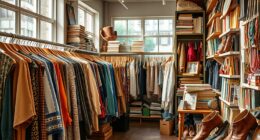When comparing hemp and traditional fabrics, you'll see that hemp's environmental footprint is much lighter. It requires significantly less water and no pesticides, promoting healthier ecosystems. Hemp also sequesters more CO2 than many forests, helping combat climate change. Plus, its durability means longer-lasting products that reduce waste. While traditional fabrics often rely on harmful chemicals and high water use, hemp shines as a sustainable alternative. However, there are considerations around energy use and recycling challenges that are worth exploring. To get the full picture, you'll want to look deeper into how these fabrics impact our environment.
Key Takeaways
- Hemp requires significantly less water than cotton, using only 4.23 liters per kg compared to cotton's 57.1 liters, promoting sustainability.
- Hemp cultivation does not rely on pesticides, reducing toxic runoff and protecting water systems, unlike many traditional fabric crops.
- Industrial hemp sequesters substantial CO2, outperforming forests with potential sequestration of nearly 8.77 tons per acre.
- Hemp fibers are more durable, lasting longer than traditional fabrics, which reduces the frequency of replacements and overall resource consumption.
- The full utilization of the hemp plant maximizes economic efficiency, while traditional fabric production often leaves parts of the plant unused.
Water and Land Usage
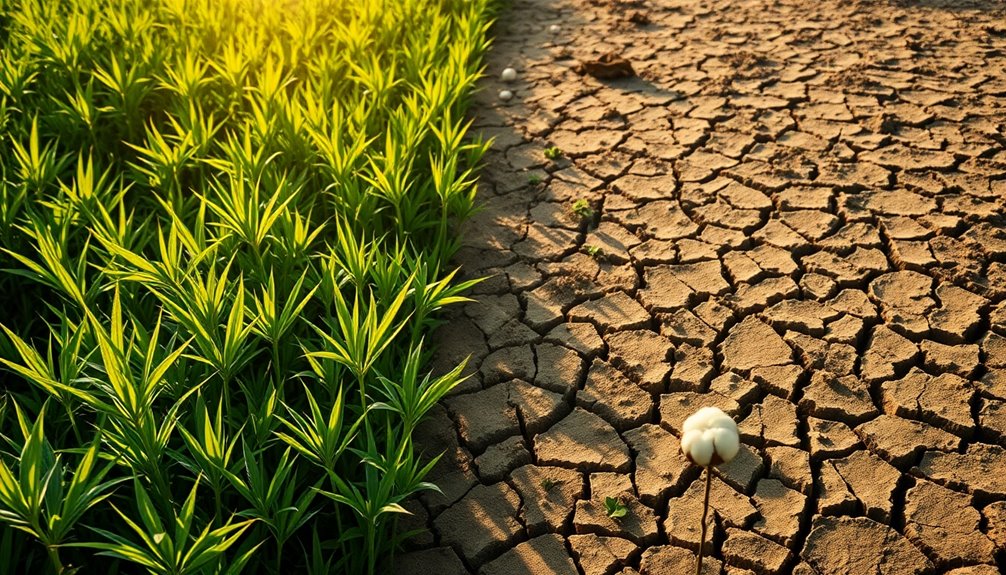
When considering sustainable options, how does hemp stack up against traditional fabrics like cotton in terms of water and land usage? Hemp cultivation requires about half the water that cotton does. You'll find that it only takes 4.23 liters to produce hemp compared to a staggering 57.1 liters for the same amount of cotton.
Plus, hemp thrives as a rainfed crop, making it an excellent option in dry regions where other plants struggle and conserving this precious resource. Additionally, hemp acts as a carbon sink, absorbing more CO2 than many other plants, which further highlights its environmental benefits.
On the land usage front, hemp's efficiency shines even brighter. It yields between 1200-2000 kilos of fiber per hectare, whereas cotton only produces 300-1100 kilos. This means you'll need almost half as much land to grow the same amount of hemp fiber as cotton.
Hemp's dense growth helps it outcompete weeds, further reducing land requirements and improving soil health. Its adaptability to various climates makes it versatile, preventing soil erosion through its deep roots.
Pesticide and Herbicide Impact
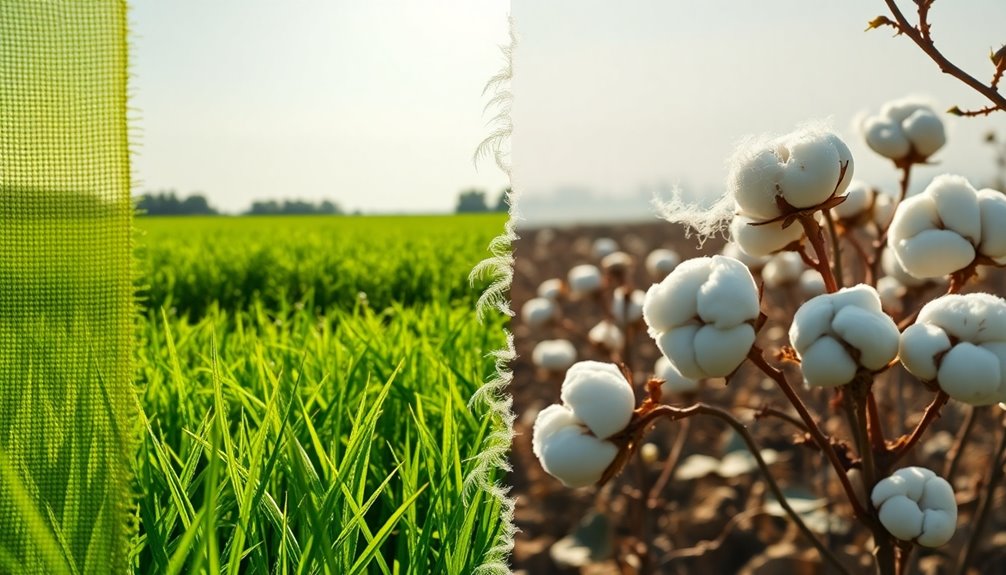
The environmental consequences of pesticide and herbicide use starkly contrast between hemp and traditional fabric cultivation. When you look at hemp, it thrives without pesticides, as the plant isn't prone to many pests. Its rapid growth naturally crowds out weeds, eliminating the need for herbicides. This deep-rooted plant not only protects the soil but also reduces the necessity for chemical interventions. You can even find organic hemp that adheres to strict European regulations, avoiding synthetic crop protection agents entirely.
On the other hand, traditional fabrics like cotton require extensive pesticide and herbicide application to maintain high yields. This reliance on chemicals not only contributes to water depletion and soil degradation but also releases toxins into the environment, harming both biodiversity and human health. Furthermore, hemp's phytoremediation ability allows it to clean the soil by absorbing toxins, enhancing its positive environmental impact.
The intensive chemical processes used in cotton production pose significant risks compared to the natural approach of hemp cultivation. By choosing hemp, you're opting for a fabric that minimizes environmental impact, promoting healthier ecosystems and safer agricultural practices. This choice can lead to a more sustainable future in textile production, prioritizing the well-being of both the planet and its inhabitants.
Carbon Sequestration Benefits
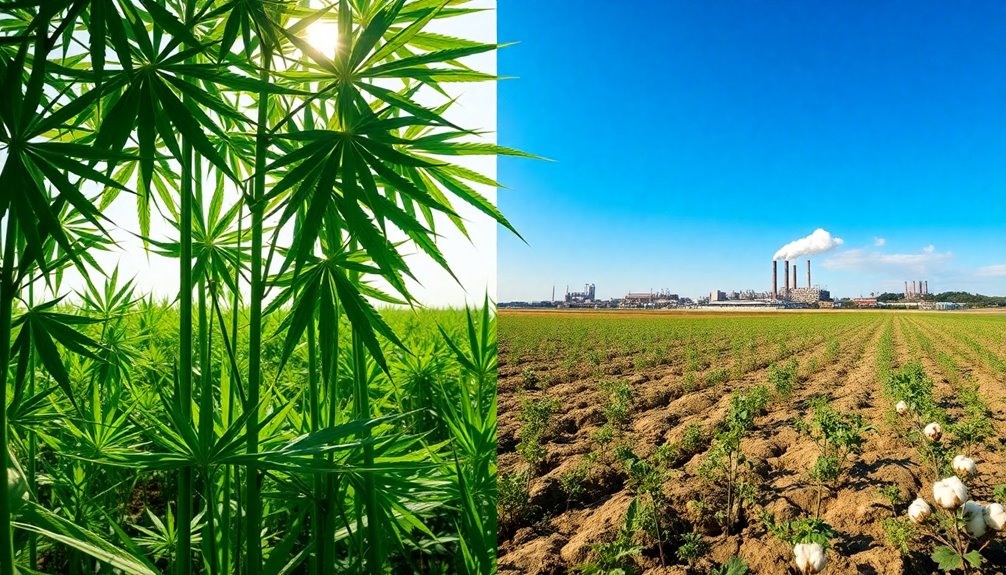
Industrial hemp stands out for its impressive carbon sequestration capacity, absorbing between 8 to 15 tonnes of CO2 per hectare of cultivation. That's twice as effective as forests, which typically capture only 2 to 6 tonnes annually.
With its rapid growth rate, hemp allows for two crops per year, potentially doubling the carbon it sequesters. One acre of industrial hemp can sequester almost 8.77 tons of CO2, making it the most effective carbon sink compared to other crops. For instance, flax only absorbs about 1.5 tons of CO2 per year.
Hemp's benefits don't stop there. The roots and leaf mulch left in the soil contribute an additional 0.46 to 0.67 tonnes of carbon per hectare, enhancing soil health. Additionally, hemp farming emits less CO2 compared to conventional agriculture, with average agricultural land in the UK emitting 3 tonnes of CO2 per hectare annually.
Moreover, products made from hemp, like building materials, lock in CO2, further reducing carbon footprints. For example, Hemcrete captures around 110 kg of CO2 per cubic meter, contrasting significantly with the CO2 emissions from standard concrete.
Durability and Longevity Comparison
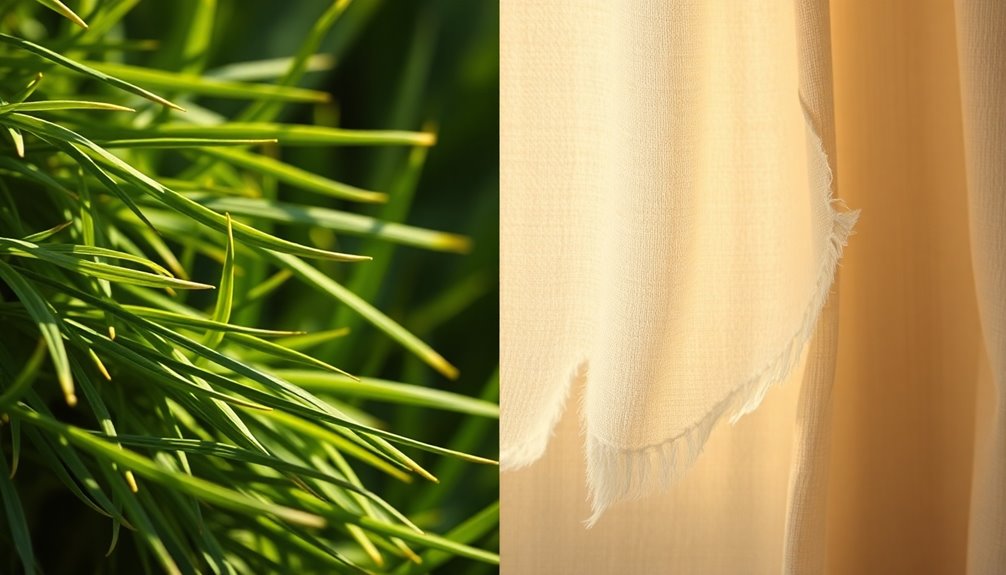
Building on the environmental benefits of hemp, its durability and longevity make it a standout choice in the fabric market. Hemp fibers are up to three times stronger than cotton, ensuring that your garments can withstand the test of time. When you choose hemp, you're opting for a fabric that not only lasts longer but also reduces the frequency of replacements, minimizing waste.
Unlike cotton, which weakens with each wash and often leads to pilling and fraying, hemp maintains its integrity. You won't have to worry about excessive wear and tear, as hemp is highly abrasion-resistant and can endure frequent friction. Additionally, its UV resistance protects against sun damage, preventing fading over time. Hemp's natural resistance to mold and mildew also contributes to its longevity, making it an ideal choice for various climates.
While linen offers breathability, it can't match hemp's robustness, making it less suitable for heavy-duty applications. Hemp also requires less delicate care compared to cotton and linen; it doesn't shrink or wrinkle easily, allowing you to enjoy its comfort without constant maintenance.
Manufacturing and Energy Considerations
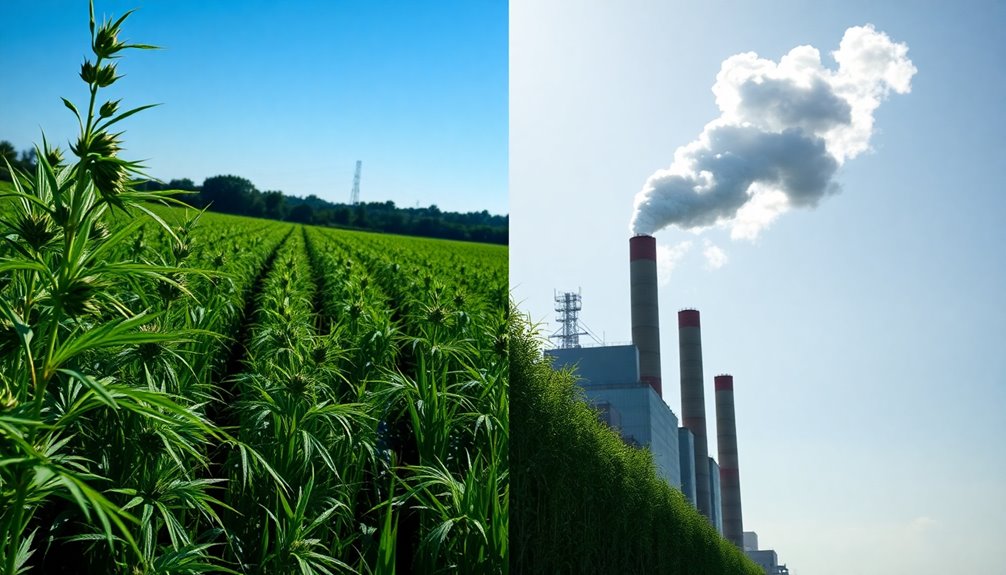
Hemp's manufacturing process presents a mix of sustainable practices and environmental challenges. On one hand, organic hemp fabric production can be achieved mechanically without harmful chemicals. This method is labor-intensive but generally more sustainable.
However, the use of chemical processing, like hemp viscose, speeds up production at an environmental cost. You'll also find that energy consumption for hemp fabric production is notably higher than for cotton, especially during bast fiber extraction and softening processes.
The reliance on fossil fuels during cultivation, along with energy-intensive irrigation and fertilizer production, adds to this higher energy footprint. One acre of industrial hemp sequesters approximately 8.77 tons of CO₂ annually, which highlights the potential environmental benefits of its cultivation. Transportation further complicates matters; hemp fabrics often travel long distances from fields to factories, increasing emissions.
Since bulky hemp materials require substantial energy for transport, establishing localized supply chains can help reduce these impacts. Additionally, while hemp cultivation itself is low-input and beneficial for soil health, industrial fertilizers can harm the environment.
Finding a balance between efficient manufacturing processes and sustainable practices is crucial for minimizing the environmental effects of hemp fabric production.
End-of-Life Options
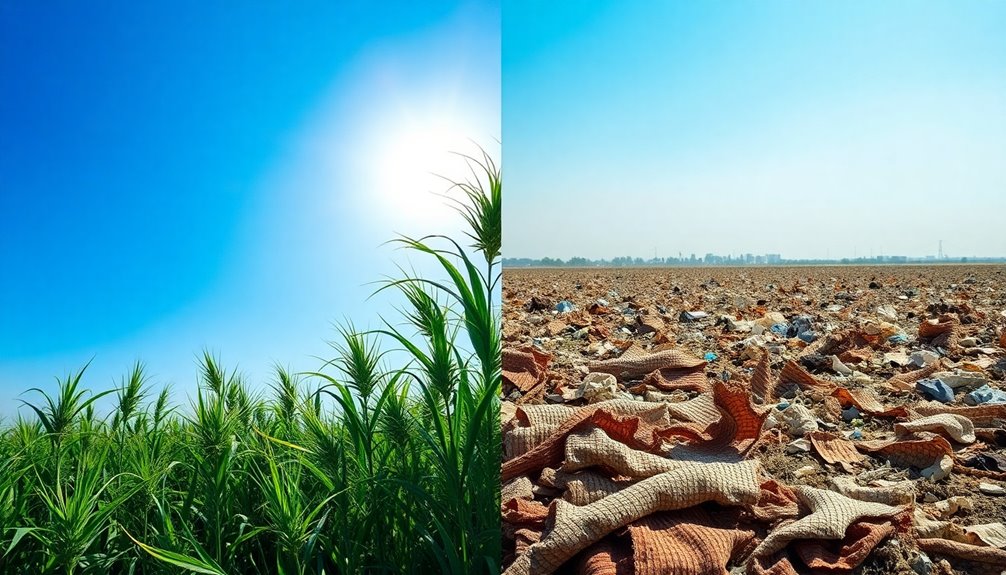
When considering the end-of-life options for fabrics, hemp stands out due to its biodegradability and compostability. Unlike many traditional fabrics, hemp can break down naturally, reducing textile waste in landfills. When you compost hemp, you're not just disposing of it; you're also returning valuable nutrients to the soil, which aligns with circular economy principles. Additionally, hemp fabrics are durable and can be reused multiple times. Their strong nature makes them ideal for repurposing, so instead of tossing an old hemp garment, you can repair or creatively transform it. This practice minimizes the need for new raw materials and extends the fabric's life cycle. Furthermore, hemp's rapid growth ensures that it is a sustainable choice that can be replenished quickly, making it a responsible fabric option for the environment.
However, recycling hemp fabrics presents challenges, particularly when they're blended with other materials like cotton. Mixed fibers complicate the recycling process, making pure hemp a more viable option. Encouraging specialized recycling facilities can help tackle this issue.
Economic Impact of Hemp
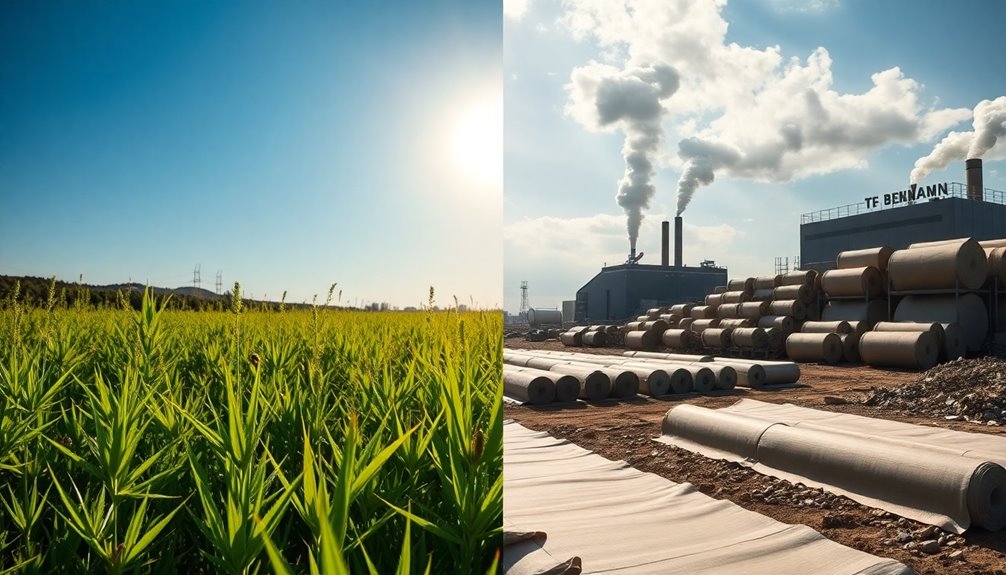
The economic impact of hemp is significant, especially considering its high fiber yield and versatility as a crop. One hectare of hemp can produce 1,200 to 2,000 kilograms of fiber, far surpassing cotton's yield of 300 to 1,100 kilograms. You'll find that hemp requires almost half the land of cotton to produce equivalent fiber, making it a more efficient choice in today's climate-sensitive world. Additionally, every part of the hemp plant can be utilized, reducing waste and maximizing economic efficiency. While hemp production is labor-intensive, involving manual processes, investments in mechanization and innovative technologies can lower costs over time. The rising demand for sustainable textiles means consumers are increasingly interested in hemp fabric, which is durable and long-lasting, potentially reshaping spending habits. Furthermore, industrial hemp contains only 0.3% THC, ensuring no psychoactive effects, which can help to alleviate historical stigma and promote its use as a sustainable resource. However, historical regulations and market barriers have limited hemp's growth potential. With changing perceptions and a growing market for sustainable fashion, hemp is starting to emerge as a viable economic alternative.
Future of Sustainable Fabrics

As consumers increasingly prioritize sustainability, the future of sustainable fabrics looks promising, with hemp emerging as a key player. Its cultivation requires significantly less water than traditional cotton, making it an environmentally friendly choice. You'll appreciate that hemp needs minimal pesticides and herbicides, which helps reduce toxic runoff, benefiting the ecosystem.
Hemp's ability to absorb more CO2 than it emits plays a crucial role in combating climate change. Additionally, its low-input nature means it can thrive without harming soil health. By improving soil structure and promoting biodiversity, hemp contributes to a healthier planet. Furthermore, hemp is known to be carbon-negative, which enhances its positive impact on the environment.
Durability is another advantage; hemp fabrics are long-lasting, reducing the frequency of replacements. Their breathability and thermal regulation keep you comfortable in various conditions, while antimicrobial properties make them suitable for sensitive skin. Plus, hemp fabrics are biodegradable, which aligns with your desire to reduce waste.
However, challenges remain, such as transportation impacts and potential energy consumption during processing. Overcoming these hurdles will be essential for the hemp industry to fully realize its potential as a cornerstone of sustainable fabrics. Embracing hemp means supporting a future where fashion and environmental responsibility coexist harmoniously. To achieve this balance, industry stakeholders must prioritize innovative solutions that mitigate negative impacts while promoting the benefits of hemp. Additionally, consumers can play a crucial role by adopting hemp fabric cleaning tips that not only extend the life of their garments but also minimize environmental impact. By fostering a culture of sustainability in fashion, we can pave the way for hemp to thrive as a leading material in eco-friendly textiles.
Frequently Asked Questions
How Does Hemp Cultivation Impact Local Wildlife and Biodiversity?
Hemp cultivation benefits local wildlife by reducing pesticide use, promoting soil health, and supporting pollination. Its dense growth suppresses weeds, enhancing biodiversity while improving ecosystem services and offering a sustainable alternative to traditional crops.
What Are the Economic Costs of Transitioning to Hemp Production?
Transitioning to hemp production involves various economic costs, including variable and fixed expenses. You'll need to consider seed, labor, and processing costs, while also evaluating potential returns and market price fluctuations for profitability.
Can Hemp Fabrics Be Dyed Sustainably?
Yes, you can dye hemp fabrics sustainably. Using fiber reactive dyes or natural dyes minimizes environmental impact, ensuring vibrant colors without harmful chemicals. Proper preparation and care also enhance the fabric's longevity and eco-friendliness.
How Does Hemp Compare to Other Sustainable Materials, Like Bamboo?
When you compare hemp to bamboo, you'll notice hemp's superior water efficiency and versatility in various climates. Its durability and low pesticide needs make it a compelling choice for sustainable materials in fabric production.
What Regulatory Challenges Does the Hemp Industry Face?
The hemp industry grapples with complex state regulations, inconsistent federal guidelines, and compliance issues. You'll find that legal challenges and public health concerns complicate the market, making it tough to navigate for consumers and producers alike.
Conclusion
In comparing hemp and traditional fabrics, it's clear that hemp offers significant environmental advantages, from lower water usage to reduced pesticide reliance. Its durability means longer-lasting products, while its carbon sequestration benefits help combat climate change. Plus, as you consider end-of-life options, hemp outshines many conventional materials. Embracing hemp could play a crucial role in the future of sustainable fabrics, making your choices not just fashionable but also environmentally responsible. Choose wisely for a greener tomorrow!







